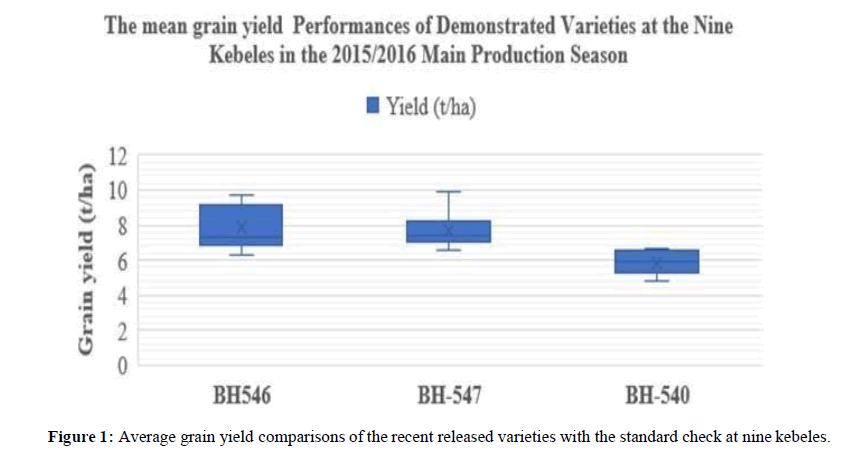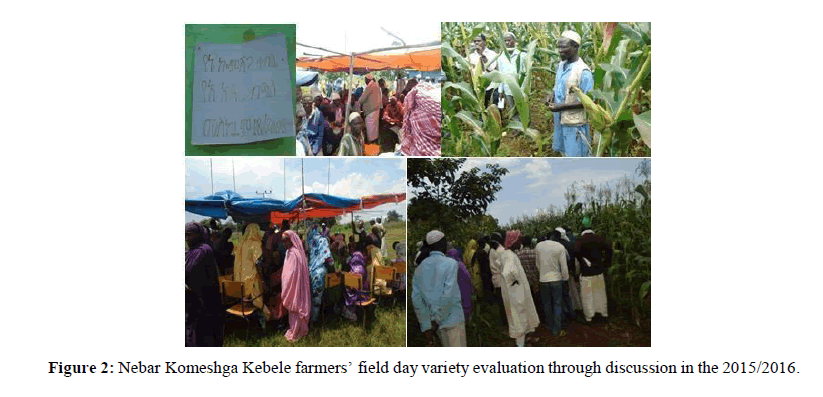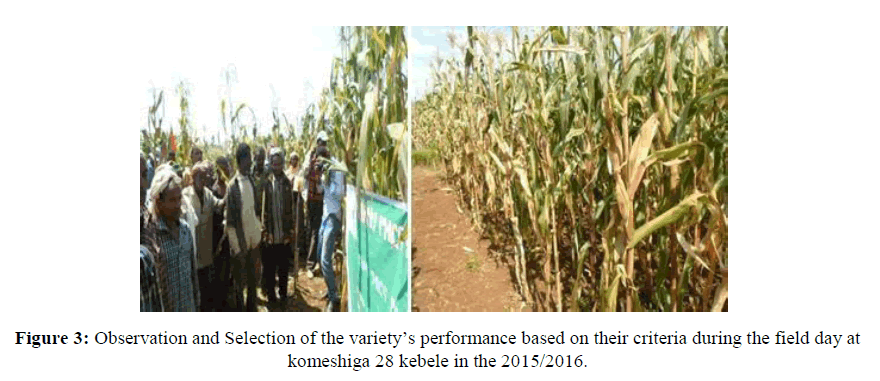ISSN : 2249 - 7412
Asian Journal of Plant Science & Research
Promotion of Recently Released Mid Altitude and Lowland Sub Humid Agro Ecologies of Maize (Zea mays L.) Varieties to Selected Districts of Assosa Zone in Benishangul Gumuz Region, Ethiopia
Yaregal Damtite1*, Hailemariam Solomon1, Anduamlak Assaye1, Firezer Girma1, Alemu Worku1, Dagne Wegary2
1Ethiopian Institute of Agricultural Research, Assosa Agricultural Research Center, Addis Ababa, Ethiopia
2International Maize and Wheat Improvement Center (CIMMYT), Addis Ababa, Ethiopia
Abstract
The advancement of improved maize varieties was directed to highly pastoralist natives and maize producing belts of settlers in Assosa Zone. The study was supported in the 2015/2016 main season with active involvement of farmers in association with Districts and Zonal bureau of agriculture. A total of nine farmers from three main maize conceivable Districts (Homosha, Assosa and Bambasi). Even though, the pairwise and direct matrices selection of farmers at the field day result showed BH547 as first in the estimating grain yield followed BH546, the overall actual mean grain yield analysis result after harvest showed BH546 the first highest in grain yield (7.9t- 1ha followed by BH547 (7.7t-1ha) and BH540 (5.8t-1ha). The crop technology demonstration has given a decent impression over the farming and pastoral societies motivated selecting their traits of interest from varieties at the time of field day using pair wise and direct matrices selection as a tool. The farmers’ preharvest variety selection ranking and actual post-harvest grain yield ranking were more scientific and similar in the two improved varieties (BH546 and BH547). The receipt of these variability’s was massive through the field day which obviously recommends the constructive impression of demonstration over farmer’s preexisted variety and maize production in Assosa zoneis to be one of the best technologies and recommended to scale out these advanced varieties in areas where they are not announced.
Keywords
Agriculture; Improved maize; Comparison; Promotion; Traits
Introduction
Maize (Zea mays L.) is one of the third -most in dispensable crops after wheat and rice in area coverage and the second next to wheat serves as staple food crops among cereals globally. It can also afford bulk of raw materials for the livestock and various agro-allied businesses crop cultivated dating to the extent 7,000 years ago in Mexico and adapted to West Africa in the first 15000’s by the Portuguese dealers. Maize inhabits supplementary about 33 million ha of sub-Saharan Africa’s evaluated 200 million ha of refined terrestrial [1]. Maize has a wide range of practices than any other cereal crops due to its world-wide distribution, high yielder, easy of processing, eagerly digestible and high photosynthetic rate with a cross pollinating species contributed to its broad morphological variability and adaptability.
Maize has a significant role in the developing countries which contributed to the highest calorie intake mainly in Ethiopia and refined in all agro ecologies and more than 9 million smallholder house-holds tangled in maize production in the country, mainly the mid and low land sub humid agro ecology is the potential and the first about 75% of national maize production area coverage in Ethiopia, followed by the high land sub humid agro ecology [2]. Benishangul Gumuz region is one of the mid and low land sub- humid agro ecologies where maize is the second most significantly grown crop followed by sorghum in the production area exposure and first in its yield potential per unit area. In Assosa zone there is favorable seasonal rain fall distribution which is suited for maize production in most districts with cultivable land accessibility and one of the major staple food crops next to sorghum. According to the 2016/2017 CSA, main cropping season report as of the total crop area coverage, 81.3% was covered by cereals of which tef, maize, sorghum and wheat accounted 24%, 17%, 15% and 13.5%, respectively [3]. In the same year from 87.4% of cereals grain production, maize, tef, wheat and sorghum covered 27%, 17.3, 15.6 and 16.4%, respectively in the region and the report exhibited the production area and average grain yield t-1 ha of maize at Metekel, Assosa and Kamashi (23398.46 ha (4 t/ha), 12328.03 (3.3 t/ha) and 10168.2 ha (4.2 t/ha)), respectively [4].
Critically in Assosa zone poor P and N availability in the soil and Lack of high yielder varieties are the main maize production factor. Additional complications stated by the farmers is deficiency of certified seed at planting season and poor management practices mainly at the pastoralist and agro pastoralist of Ethiopia. Concerning all the discrepancies, at present there are exertion sended by Non-governmental, Governmental, and societies to encourage and popularize technologies in these areas of the country [5,6]. Yet, the distribution and promotion of improved maize technologies in Assosa Zone is not sufficiently addressed since most native peoples manage their life through hunting, gathering and traditional gold mining system rather than crop production whereas settlers manage their life through crop production, but lack of improved technologies [7]. In order to solve the problem Assosa Agricultural Research Center in collaboration with Bako National Maize Research Coordinating Center and International Maize and Wheat Improvement Center (CIMMYT) occupied on the adaptation and development of maize varieties which are apposite for the mid and low land sub humid agro ecologies and there by promoting a verified variety on farmers field to evaluate the performance of diverse. Accordingly, the farmers and proficient appraisal to indorse promising practice for further scaling up exertion.
Due to this esteem the advancement was imitated in compliance with the objective of demonstrating mid and lowland sub humid advanced maize varieties and assessing farmers’ trait preference with enhancing the adoption of new technologies.
Materials and Methods
Descriptions of the valuation environment
The study was directed in Assos an administrative zone; it is located about 680 km far from Addis Ababa in the North West part of Ethiopia situated with an altitude of 1541-1553. The area receives mean annual rainfall of 1166mmwith mean annual temperature range of 15°C-28°C. It is characterized by mixed agricultural system. The dominant type ofsoil in all study sites is Nitosols and the variation in its vegetation coverage enables Assosa zone to have different cropping pattern [8].
Method of technology enactment at field level
In 2015/2016 harvesting season the demonstration was conducted in the three Districts (Homosha, Assosa and Bambasi) with active participation of farmer’s in collaboration of District Bureau of agriculture in nine major maize potential kebeles specifically Amba 12, Amba 13, Belmile, komeshga 25, komeshga 28, Nebarkomeshga, Dabus, Keshmando and Tumetin the same year using the two varieties BH546 and BH547asthe demonstration plots with BH540 as standard check. The seed of improved varieties were supplied by Bako agricultural Research Center [9]. These varieties were selected based on yield potential and wide adaptability. Individual varieties at individual farmer’s field were planted on 10 m x 10 m plot of land with spacing of 30 cm between two successive plants and 75 cm cm between two consecutive rows. The research recommended fertilizer rate was applied (DAP 150 kg and Urea in 200 kg/ha).
Variety selection
Done conducting stakeholders’ field day on the demonstration plots at two Districts, Assosa and Bambasi through matrix ranking method. During the field days, Males=188 and Females=47, totally 235.The rating performance was scored from 1 to 5 (5-excellent, 4-very good, 3-good, 2-poor and 1-very poor) for each variety. In order to do rating of importance (relative weight) 1 to 3 scoring was applied (3-very important, 2-important and 1-less important). At the same time rating of performance was multiplied by a relative weight of each variety and criterion and added to get the total score [10,11].
Data collection
Data on yield and yield constituent with social attributes were collected concerning the definite grain yield, opportunityof preferment and preference evaluation.
Data analysis
Quantitative were analyzed using average and frequency distribution while matrix ranking was done using a tool for decision-making and prioritization procedure stated [2]. Pairwise comparisons was done using the following steps:
First farmer’s criteria were identified and arranged to be ranked in a square matrix then pairs of criteria were compared across rows, finally the results s of each criteria evaluation was ranked and assigned weights (Figure 1).
Pairwise comparison was applied comparing among varieties and farmer’s trait preference in pairs to critic which variety and trait is ideal ended others or has a better measurable property at the time of farmers’ field day evaluation (Table 1) [5]. This comparison assisted to control how to access possibilities provided that rating and ranking decision-making accordingly.
Table1:Summarized farmer’s Selection Criteria for Variety Evaluation at all locations.
| Field days and Selection Time | Selection criteria |
|---|---|
| At the physiological maturity period of the crop | Expected Grain Yield |
| Disease Resistance | |
| Ear Husk cover | |
| Stalk and Root logging resistance | |
| Plant and Ear height |
Step 1: The number of frequencies was added that an option was selected as favored over another possibility and place the number of times in the score column for the corresponding row. Therefore:
- Grain yield was voted four times throughout the matrix, so its score is 4.
- Disease Resistance was elected three times throughout the matrix, so its score is 3.
- Husk cover was elected two times at the fourth and fifth rows throughout the matrix, so its score is 2.
- SL and RL were chosen once in the fifth-row trough the matrix, so its score is 1.
- Plant and ear height were not voted, so the score is 0.
Table 2: Direct matrix ranking evaluation by group of farmers at Komeshga 28 Kebelein 2015/2016.
| Selection criteria | Relative Weight (%) | BH546 | BH547 | BH540 |
|---|---|---|---|---|
| Expected Yield | 40 | 11(4) | 16(5) | 5(2) |
| Disease resistance | 30 | 9(4) | 14(5) | 8(1) |
| Husk cover | 20 | 9(3) | 11(4) | 5(1) |
| SL and RL resistance | 10 | 7(3) | 9(4) | 8(1) |
| Plant and Ear height | 0 | 5(2) | 8(3) | 5(2) |
| Total | 100 | 41 | 58 | 31 |
| Ranking score | - | 2 | 1 | 3 |
Comparable assortment technique was used at Bambini field day. Conferring to farmers selection criteria, expected grain yield and disease resistance were also their very important traits and voted as BH547 excellent with 9 farmers while BH546 scored very good with 8 voice, but the concrete grain yield later harvest for BH546 and BH547was 8.8 and 8.3 t-1ha respectively whereas BH540 verified 6.5 t-1ha which implies the performance of each variety was consistent at each location. The values of relative weight, pairwise scoring and ranking were similar using and it is similar procedures at this location with the score at Komesh 28 Kebele except the number of farmers giving vote at each criterion (Figure 2). The actual grain yield of each variety was calculated using moisture content and field weight during harvesting for each plot then converted in to t/ha at all locations (Figure 3). In general farmer’s trait preference and criteria were independent and democratic at the time of field day evaluations, but the experts were only guiding the program.
Discussion and Conclusion
Embracing of new improved technologies necessitates extensive progression for innovative varieties in new areas where improved technology is not sound announced particularly in the pastoralist and agro pastoralists. The overall nine demonstrations were effective and improved maize technologies accepted by maize farmers. Since the overall farmers direct and pair wise ranking result exhibited BH-547 and BH-546 are the best varieties which imply the researchers should consider the farmers trait preference for further breeding strategies. The highest mean grain yield was obtained from BH546. Yet, there is still immense gap between the natives and settlers out the technology acceptance with variation of maize production area coverage. Consequently, based on this yield difference the farmer’s and researchers recommended further popularize these advanced maize varieties in the farmers and investors at maize production areas where is not introduced before critically around natives who manage their life via hunting and gathering.
References
- Abate T, Fisher M, Abdoulaye T, Kassie GT, Lunduka R, et al. Characteristics of maize cultivars in Africa: How modern are they and how many do smallholder farmers grow? Agri Food Sec. 2017, 13:2-10.
- Abate T, Shiferaw B, Menkir A, Wegary D, Kebede Y, et al. Factors that transformed maize productivity in Ethiopia. Food Sec. 2015, 7:965-981.
- Abera W, Hussein S, Derera J, Worku M, Laing MD, et al. Preferences and constraints of maize farmers in the development and adoption of improved varieties in the mid-altitude, sub-humid agro-ecology of western Ethiopia. Afri J Agri Rese. 2013, 8:1245-1254.
- Central Statistical Agency (CSA) Agricultural sample survey central statistical agency the federal democratic republic of Ethiopia. Crops area and production of major Crops. Addis Ababa Ethiopia. 2017.
- Chen X, Chen F, Chen Y, Gao Q, Yang X, et al. Modern maize hybrids in Northeast China exhibit increased yield potential and resourceuse efficiency despite adverse climate change. Glob Chan Bio. 2013, 19:923-936.
- Galinat WC. The origin of corn. Agronomy. 1988, 18:1-31.
- Gay K, Eric S, Galino GS. Matrix ranking: A tool for decision-making and prioritization. 2016, 7:63-69.
- Harder A, Ganpat W, Moor A, Strong R, Lindner J. An assessment of extension officers’ self-perceived programming competencies in selected Caribbean countries. J Inter Agri Ext Edu. 2013, 20:33-46.
- Maazou AR, Qiu J, Mu J. Liu Z. Utilization of wild relatives for maize. Afri J Plan Sci. 2017, 11:105-113.
- Muli JK, Budambula NL, Mweu CM, Imbo MC, Anami S. Genetic improvement of African maize towards drought tolerance. Adv Life Sci Tech. 2016, 48:1-9.
- Yaregal D, Firew M. Genetic variability of improved maize varieties for acidic soil tolerance under contrasting environments in Assosa, Ethiopia. J Agri Sci. 2018, 8:332-350.

Open Access Journals
- Aquaculture & Veterinary Science
- Chemistry & Chemical Sciences
- Clinical Sciences
- Engineering
- General Science
- Genetics & Molecular Biology
- Health Care & Nursing
- Immunology & Microbiology
- Materials Science
- Mathematics & Physics
- Medical Sciences
- Neurology & Psychiatry
- Oncology & Cancer Science
- Pharmaceutical Sciences



